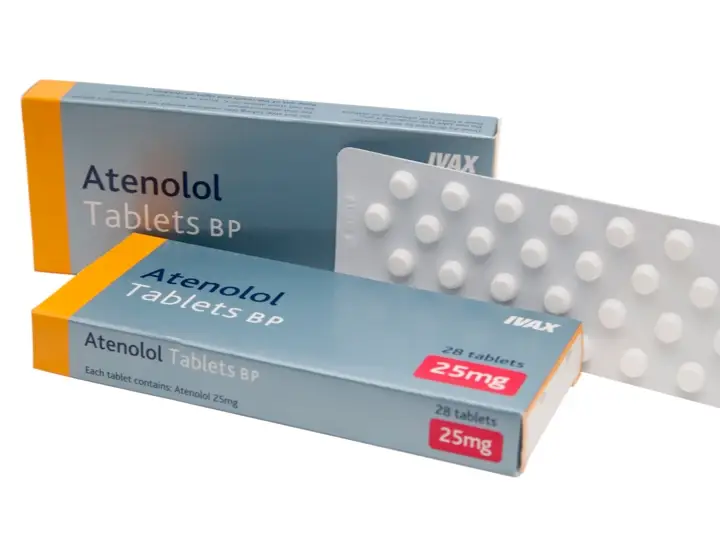
| Introduction | Atenolol, available under brand names of Tenormin, Blokium, Zafnol is Synthetic beta-1 selective blocker. Atenolol is used to treat hypertension, chronic angina, and to lower mortality in individuals with known or suspected myocardial infarction who are hemodynamically stable. | ||||||||||||||||||||
| Class of Medicine | Atenolol is a second-generation beta-1-selective adrenergic antagonist lowers myocardial contractility, blood pressure, and heart rate. | ||||||||||||||||||||
| Mode of Action | Because it selectively binds to the 1-adrenergic receptor as an antagonist up to a reported 26 fold more than 2 receptors, atenolol is a cardioselective beta-blocker. 15 Due to the greater population of this receptor in cardiac tissue, selective action at the 1 receptor results in cardioselectivity. Therapeutic doses can still cause some binding to 2 and potentially 3 receptors, but the effects caused by antagonising these receptors are greatly diminished compared to those caused by non-selective drugs. Due to the Gs coupling between the 1 and 2 receptors, inhibiting their activation decreases the activity of adenylyl cyclase and the downstream signalling that it produces via cyclic adenosine monophosphate and protein kinase A. PKA is hypothesised to mediate the activation of ryanodine receptors and L-type calcium channels in cardiomyocytes by phosphorylating these proteins. The release of calcium from the sarcoplasmic reticulum (SR) and an increase in contractility can then be caused by the 16 L-type calcium channels, which can first cause an increase in intracellular calcium. By phosphorylating phospholamban, which in turn enhances the SR Ca2+ ATPase’s affinity to promote calcium reuptake into the SR, PKA also contributes to the termination of contraction. Additionally, it phophorylates troponin I to lessen the protein’s affinity for calcium. Both of these occurrences result in a contraction reduction, which when combined with the initial contraction increase, enables faster cycling and, as a result, a higher heart rate with increased contractility. PKA is hypothesised to mediate the activation of L-type calcium channels and ryanodine receptors in cardiomyocytes by the phosphorylation of these proteins. The ryanodine receptors are then triggered to release calcium that has been held in the sarcoplasmic reticulum (SR), leading to enhanced contractility, after an initial spike in intracellular calcium is provided by 16 L-type calcium channels. The phosphorylation of phospholamban by PKA, which enhances the SR Ca2+ ATPase’s affinity to promote calcium absorption into the SR, contributes to the termination of contraction as well. In order to lessen troponin I’s affinity for calcium, it also phophorylates the protein. When combined with the initial rise in contraction, both of these occurrences result in a contraction reduction, enabling faster cycling and, as a result, a greater heart rate with increased contractility. | ||||||||||||||||||||
| Indications | A second-generation beta-1-selective adrenergic antagonist called atenolol is used to treat acute myocardial infarction, angina pectoris, and hypertension. Treatment of arrhythmias, migraine prevention, paroxysmal supraventricular tachycardia, alcohol withdrawal, thyrotoxicosis prevention, and prophylaxis against subsequent myocardial infarction are only a few of the non-FDA authorised uses. In cases of infantile hemangiomas, atenolol may also be used instead of propranolol, though further study is necessary before use. | ||||||||||||||||||||
| Avaiability & Usage | For oral treatment, atenolol comes in 25 mg, 50 mg, and 100 mg tablets; 0.5 mg/mL is also available for intravenous injection. Depending on the indication, a different dosage and administration method is used. Hypertension Chronic chest pain Myocardial Infarction Acute For instance, the FDA advises giving an adult a 5-minute IV atenolol injection followed by a 10-minute IV injection of another 5-mg dose. After 12 hours, an oral dose of 50 mg should be taken. Then, for the following 6 to 9 days or until the patient is discharged from the hospital, oral dose might be either 50 mg twice daily or 100 mg once daily. Migraine Prevention T-wave supraventricular rhythm Coronary infarction Thyrotoxicosis Employing in the Particular Patient Populations Considerations for Pregnancy: Considerations When Breastfeeding: Plasma protein binding is primarily responsible for the excretion of beta blockers in breast milk Drugs like atenolol (10% PPB), which have low plasma protein binding, are extensively excreted in breast milk. | ||||||||||||||||||||
| Side Effects | The following are atenolol’s side effects, per the product label. Avoid stopping atenolol suddenly because doing so could make your angina, acute myocardial infarction, or ventricular arrhythmias worse. It is advised that the dose be reduced gradually. | ||||||||||||||||||||
| Drug Interaction |
| ||||||||||||||||||||
| Caution | In some cases, atenolol may result in cardiac failure. If you experience discomfort or pain in your chest, consult a doctor right once; Swelling of the face, fingers, feet, or lower legs; dilated neck veins; extreme fatigue; irregular breathing; an irregular heartbeat; weight gain; or wheezing | ||||||||||||||||||||
| Available Brands | Tenormin Blokium Zafnol |


